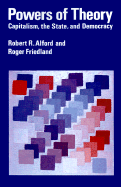Book contents
- Frontmatter
- Contents
- Preface
- Acknowledgments
- Introduction: State and society in theoretical perspective
- 1 Theoretical perspectives as modes of inquiry
- PART I THE PLURALIST PERSPECTIVE
- 2 State and society in pluralist perspective
- 3 The democratic state and consensus
- 4 The democratic state and participation
- 5 The pluralist perspective on the bureaucratic state
- 6 The pluralist perspective on the capitalist state
- PART II THE MANAGERIAL PERSPECTIVE
- PART III THE CLASS PERSPECTIVE
- PART IV THEORY, POLITICS, AND CONTRADICTIONS IN THE STATE
- Glossary
- Bibliography
- Name index
- Subject index
5 - The pluralist perspective on the bureaucratic state
Published online by Cambridge University Press: 01 June 2011
- Frontmatter
- Contents
- Preface
- Acknowledgments
- Introduction: State and society in theoretical perspective
- 1 Theoretical perspectives as modes of inquiry
- PART I THE PLURALIST PERSPECTIVE
- 2 State and society in pluralist perspective
- 3 The democratic state and consensus
- 4 The democratic state and participation
- 5 The pluralist perspective on the bureaucratic state
- 6 The pluralist perspective on the capitalist state
- PART II THE MANAGERIAL PERSPECTIVE
- PART III THE CLASS PERSPECTIVE
- PART IV THEORY, POLITICS, AND CONTRADICTIONS IN THE STATE
- Glossary
- Bibliography
- Name index
- Subject index
Summary
The operations of democratic institutions define the bureaucratic aspect of the state in the pluralist perspective. Programs, funding, and leadership of state agencies are subject to shifting currents of public opinion and electoral choice. Bureaucrats are vulnerable to removal; programs are subject to cuts. Within the state, bureaucracies compete with each other for support and resources, like any other interest group. Even the internal operations of such organizations are not “bureaucratic” in the usual pejorative sense of being rule-bound and inflexible. Rather, bureaucracies are seen as coalitions of individuals maximizing their own benefits. Bureaucracies are highly political, shot through with personal communications and favors, and possess cultures just like communities and ethnic groups. Bureaucracies are established as a result of a collective choice to implement social values and ultimately arise from the diverse perceptions and needs of individuals. Bureaucratic centralization is not seen as a structural imperative but is an impermanent social choice. A continuous tension exists between the possibilities of centralizing decisions to serve the public interest or decentralizing them to serve the preferences of particular constituencies.
Bureaucracies themselves reflect the pluralism of governing institutions. Each has its own history, surviving crises of leadership succession by virtue of having become identified with values of the population and becoming institutionalized. Bureaucratic organizations are natural social organisms, with a life history of growth, development, and decline.
- Type
- Chapter
- Information
- Powers of TheoryCapitalism, the State, and Democracy, pp. 112 - 135Publisher: Cambridge University PressPrint publication year: 1985

